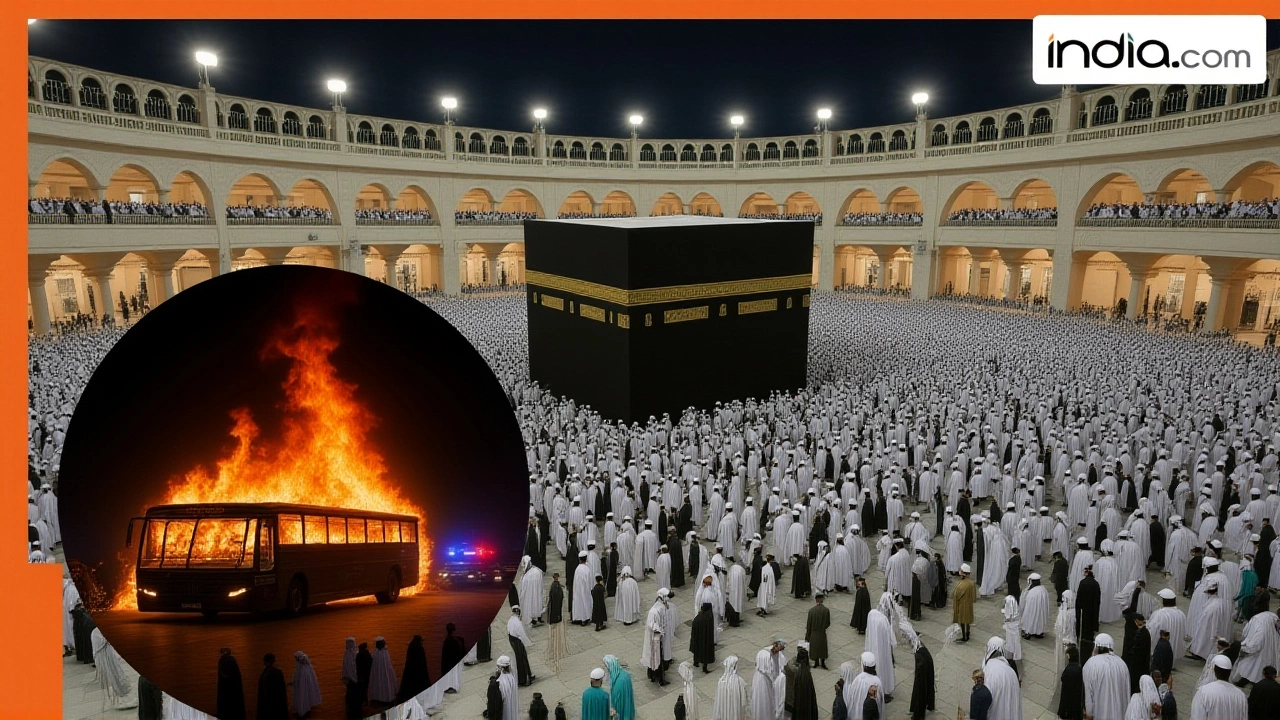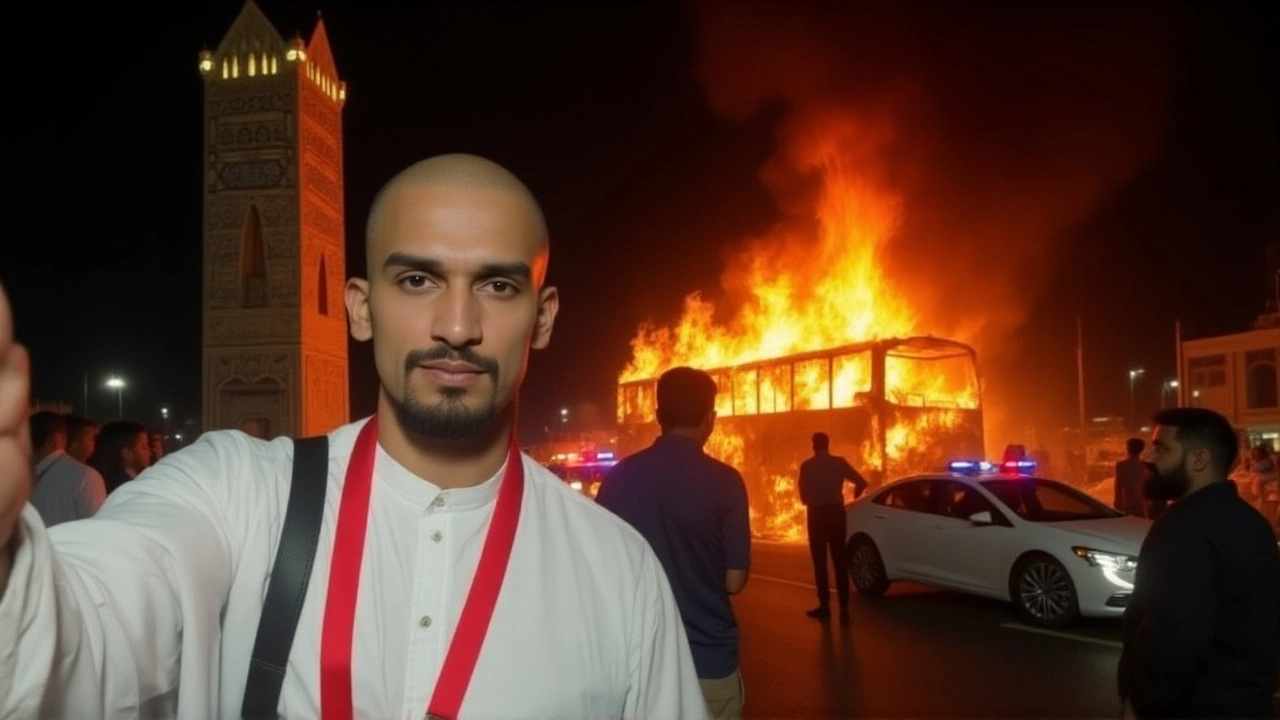On the dark, quiet stretch of road 25 kilometers from Medina, a diesel tanker slammed into a passenger bus carrying 46 Indian Umrah pilgrims just after 3 a.m. on Monday, November 17, 2025. In seconds, the vehicle erupted in flames. Forty-five people burned alive. One man jumped from a window and survived. The crash wasn’t just a tragedy—it was a gut punch to families across India, especially in Hyderabad, where most victims hailed from two closely connected families in Telangana. One of them, Abdul Gani Sirtti, was identified by his brother through a tearful call to a local news crew. "We thought we were saying goodbye before the pilgrimage," the brother said. "We didn’t know it was forever."
Who Were the Victims?
All 45 deceased were Indian nationals, according to the Indian Consulate General in Jeddah. Most came from Hyderabad’s Old City and surrounding neighborhoods in Telangana. Among them was a 58-year-old man from Karnataka who had been working in the United Arab Emirates for over a decade, returning home to perform Umrah before heading back to Dubai. The bus had left Medina after a brief rest stop, bound for Mecca, the final destination for millions of Muslims each year. No children were aboard, but several elderly pilgrims—some in their 70s—were among the dead. Many had saved for years to make this journey. Now, their bodies remain in Saudi Arabia, awaiting repatriation.
Immediate Aftermath: Chaos, Calls, and Consulates
The sole survivor, a 32-year-old man from Secunderabad, suffered burns and shock but was conscious enough to tell rescuers his name and where he was from. He’s now recovering in a Medina hospital under guard. Meanwhile, the Indian Consulate General in Jeddah sprang into action, setting up a temporary camp at the Indian Haj Pilgrims Office within hours of the crash. Helplines were activated in New Delhi and Hyderabad, staffed by volunteers who fielded over 1,200 calls in the first 24 hours. Families were notified at 1:30 p.m. local time on November 17—many by phone, others by police knocking on doors.
"We didn’t know how to tell them," said a local official in Hyderabad who helped deliver the news to one family. "They’d just posted photos of their son boarding the bus. Now they’re asking for the body. We don’t even know when it’ll come home."
Leaders Respond
Narendra Modi, India’s Prime Minister, posted a somber message on X (formerly Twitter): "Deeply saddened by the tragic loss of life in the bus accident near Medina. Our thoughts are with the bereaved families. Indian authorities are in close touch with Saudi officials." Within minutes, the Iranian Ministry of Foreign Affairs issued a formal condolence to "the Indian government and nation," a rare gesture of solidarity.
In Hyderabad, Police Commissioner V. C. Sajjanar called the incident "deeply distressing," while Telangana Chief Minister Revanth Reddy announced an ex gratia payment of 500,000 rupees—roughly $6,000 USD—to each family. "No amount of money can replace a life," Reddy said in a televised address. "But we owe them that much."
Why Did This Happen?
Saudi authorities have not yet released a final report, but preliminary findings suggest the diesel tanker—likely carrying fuel for local service stations—veered into the bus’s lane. Was the bus moving? Was it stopped? Did the driver fall asleep? Was the tanker overloaded? The answers matter. Saudi Arabia’s General Directorate of Traffic is investigating, and their findings could reshape how pilgrim transport is regulated.
This isn’t the first time pilgrims have died in Saudi road accidents. In 2015, over 700 people were crushed in a stampede near Mecca. In 2019, a bus carrying Pakistani pilgrims flipped near Jeddah, killing 23. But this is the deadliest single-vehicle crash involving Indian pilgrims in decades.
According to a 2023 World Health Organization report, Saudi Arabia cut traffic fatalities by nearly 35% between 2016 and 2021 thanks to speed cameras, stricter licensing, and better road design. Yet pilgrim transport remains a weak link. Many buses are privately operated, poorly maintained, and driven by overworked, underpaid contractors. No mandatory safety audits exist for vehicles carrying religious groups.

What Comes Next?
The Indian government is pushing Saudi Arabia for a full forensic report, including black box data from the tanker and bus. The Ministry of External Affairs has also requested a joint safety review for all Umrah transport routes. Meanwhile, families in Telangana are holding vigils. Some are demanding a national memorial. Others just want answers.
"They didn’t die on a battlefield," said a local imam in Hyderabad. "They died because no one cared enough to make sure the bus was safe."
Background: The Weight of Umrah
Umrah, often called the "lesser pilgrimage," is a non-compulsory but deeply spiritual journey undertaken by Muslims year-round. Unlike Hajj, which is mandatory once in a lifetime for those who can afford it, Umrah can be performed anytime. In 2024, over 12 million Muslims performed Umrah—nearly half of them from South Asia. India alone sent more than 1.8 million pilgrims. Most travel through licensed agencies, but many—especially from smaller towns—book through informal networks. The lack of oversight is dangerous.
Between 2020 and 2024, at least 14 Indian pilgrims died in Saudi road accidents. None triggered national outrage. Until now.
Frequently Asked Questions
How did the Indian government respond to the crash?
India activated emergency helplines in New Delhi and Hyderabad, deployed the Consulate in Jeddah to coordinate with Saudi authorities, and secured the repatriation of remains. Prime Minister Narendra Modi publicly expressed condolences, while Telangana’s Chief Minister announced ₹500,000 in ex gratia payments to each family. The Ministry of External Affairs is demanding a full forensic investigation and has requested a joint safety review for all Umrah transport routes.
Why are pilgrim buses in Saudi Arabia considered unsafe?
Many buses transporting pilgrims are privately owned, poorly maintained, and operated by contractors with minimal oversight. Unlike commercial fleets, they’re not subject to mandatory safety inspections. Drivers often work 14-hour shifts with little rest. The 2023 WHO report noted Saudi Arabia improved overall road safety, but pilgrim transport remains an exception—largely because it’s treated as a religious service rather than a regulated transport sector.
Who is the sole survivor, and what’s his condition?
The sole survivor is a 32-year-old man from Secunderabad, Hyderabad, who jumped from a window as flames engulfed the bus. He suffered second-degree burns on his arms and face and is currently hospitalized in Medina under police guard. He has identified himself and provided key details to investigators, including the time of impact and the direction of the tanker. His testimony could be critical to determining fault.
When will the victims’ bodies be returned to India?
The Indian government has not confirmed a timeline, but repatriation typically takes 7–14 days in such cases, depending on forensic procedures and diplomatic coordination. Bodies are being held at a morgue in Medina under Saudi custody. Families are being asked to provide DNA samples and personal effects for identification. Some have already received ashes; others are still waiting.
What’s being done to prevent future crashes?
India is pushing Saudi Arabia to implement mandatory safety standards for all pilgrim transport, including GPS tracking, driver rest requirements, and vehicle inspections. The Telangana government has already begun auditing local travel agencies that organize Umrah trips. A parliamentary committee is expected to convene in December to draft new guidelines for overseas religious travel, potentially requiring government-approved operators only.
Why did this crash get so much attention compared to past incidents?
This was the deadliest single-vehicle crash involving Indian pilgrims in over 20 years—and it happened on a route used by millions. Social media amplified the grief: videos of families weeping, photos of empty chairs at home, messages from survivors. Unlike past accidents, this one hit close to home for middle-class families in Hyderabad, not just rural communities. The emotional weight, combined with the sheer number of victims, forced national attention.
